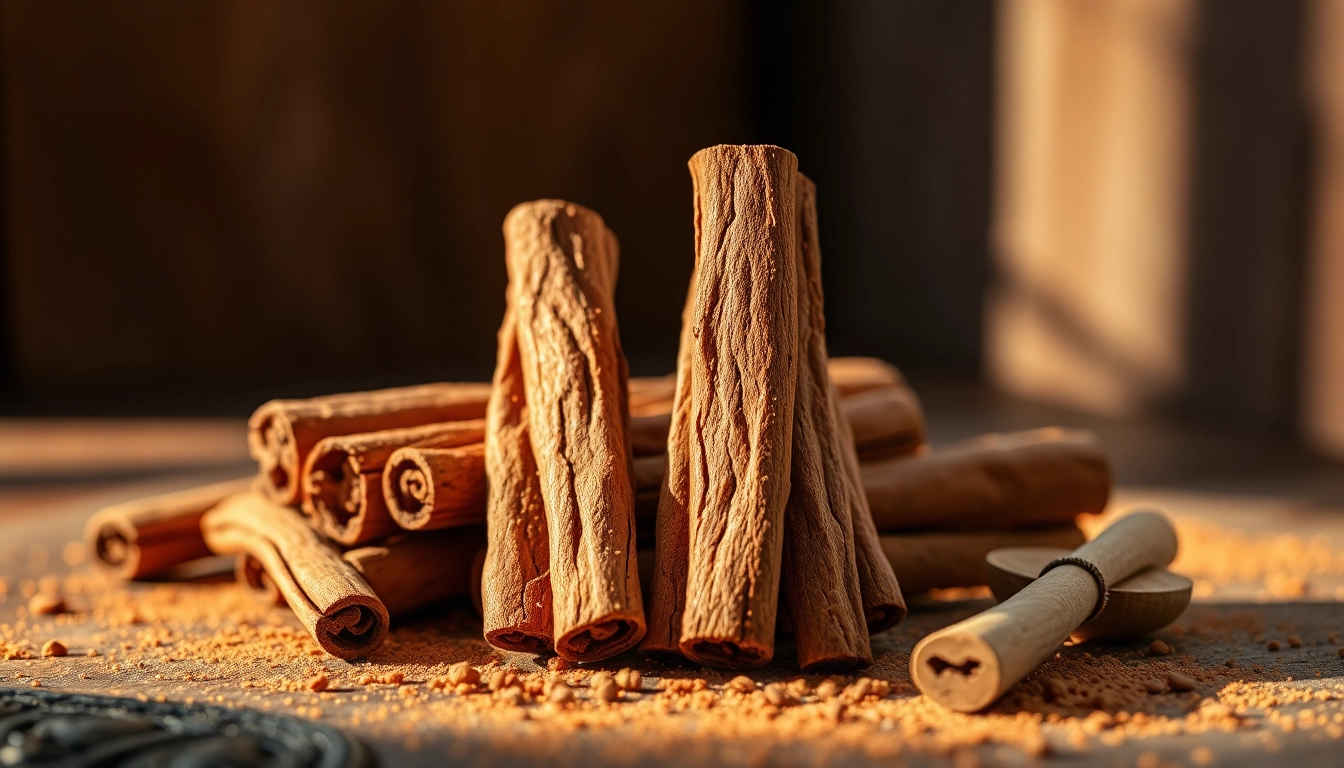
Understanding Cinnamon Bark: An Overview
Cinnamon bark holds a special place in both culinary traditions and natural medicine, known for its warm flavor and aromatic properties. Derived from the inner bark of trees belonging to the Cinnamomum genus, it is used globally in various dishes, providing a unique twist to classic flavors. But its utility isn’t limited to the kitchen; cinnamon bark is also celebrated for its health benefits. For those exploring the world of spices and natural health solutions, Cinnamon Bark deserves a deeper look.
What is Cinnamon Bark?
Cinnamon bark is the aromatic outer layer of the cinnamon tree’s inner bark, primarily harvested from two different varieties: Ceylon (or true cinnamon) and Cassia (often referred to as Chinese cinnamon). When the bark is harvested, it curls into quills as it dries, which can be used whole or ground into powder. The spice is not only praised for its flavor but also for its rich history of medicinal use, having been employed in traditional practices for thousands of years.
Types of Cinnamon Bark: Cassia vs. Ceylon
Understanding the differences between Cassia and Ceylon cinnamon is crucial for both culinary and health-related purposes. Ceylon cinnamon is often considered “true cinnamon” and is milder and sweeter than its counterpart. It contains lower levels of coumarin, a compound that can be harmful in high doses. Cassia, on the other hand, is more pungent and has a harsher taste, commonly used in commercial cinnamon products. The choice between the two often depends on intended use; Ceylon is favored in gourmet cooking, while Cassia is prevalent in many everyday baking recipes.
Cinnamon Bark’s Historical Significance
The rich history of cinnamon dates back to ancient Egypt, where it was prized not only for culinary uses but also in embalming and rituals. It was so valued that it was considered a gift worthy of kings and deities. From ancient trade routes to its significance in various cultures, such as in Ayurvedic medicine, cinnamon has played a vital role in human history and health.
Health Benefits of Cinnamon Bark
Cinnamon bark is not only flavorful but also packed with numerous health benefits that stem from its rich array of antioxidants and beneficial compounds.
Antioxidant Properties of Cinnamon Bark
Cinnamon is loaded with powerful antioxidants, such as polyphenols, which protect the body from oxidative stress and inflammation. Research suggests that the antioxidants found in cinnamon may help combat the effects of chronic conditions, improving overall health and potentially reducing the risk of disease.
Cinnamon Bark for Digestive Health
Traditionally, cinnamon has been used to treat digestive ailments. It is believed to help alleviate gas and bloating, stimulate appetite, and even prevent nausea. Its soothing properties make it an excellent addition to herbal teas and tonics that target digestive discomfort.
Cinnamon Bark and Blood Sugar Regulation
Cinnamon bark has garnered attention for its potential role in stabilizing blood sugar levels. Studies have indicated that it may enhance insulin sensitivity and lower fasting blood sugar levels. This makes it particularly interesting for individuals managing diabetes or insulin resistance. However, it should complement, not replace, medical treatments.
Culinary Uses of Cinnamon Bark
Cinnamon is a versatile ingredient that enhances flavors and adds warmth to both sweet and savory dishes. Its culinary uses are varied and culturally rich.
Enhancing Dishes with Cinnamon Bark
Incorporating cinnamon bark into recipes can elevate dishes significantly. It works well in spiced curries, stews, and marinades, providing depth and an aromatic lift. In baking, it shines in cakes, cookies, and bread, often paired with other spices like nutmeg and clove.
Traditional Recipes Featuring Cinnamon Bark
Many cultures have traditional dishes that highlight cinnamon bark. In Indian cuisine, for example, it is an essential ingredient in garam masala, which adds warmth and complexity to various curries. Middle Eastern dishes often feature cinnamon in rice pilafs and meat stews, illustrating its global appeal and versatility.
Cinnamon Bark in Baking: Tips and Tricks
When using cinnamon bark in baking, it is beneficial to grind it into a powder for even distribution unless using whole quills for infusing flavors. Experimenting with different amounts can yield a range of flavors. For instance, using more cinnamon can add warmth, while using less can create a more subtle spice note.
Choosing and Storing Cinnamon Bark
The quality and storage of cinnamon bark significantly affect its flavor profile and longevity.
How to Select Quality Cinnamon Bark
When selecting cinnamon bark, look for quills that are firm and not brittle. They should have a strong, sweet aroma without any off-putting or musty smells. True cinnamon (Ceylon) is often lighter in color and more delicate compared to Cassia, which tends to be darker and thicker.
Proper Storage Techniques for Freshness
To maintain the freshness of cinnamon bark, store it in a cool, dry place away from sunlight, preferably in an airtight container. This prevents it from absorbing moisture and losing its aromatic properties. For maximum shelf life, consider freezing it if you have a large quantity.
Understanding Cinnamon Bark vs. Ground Cinnamon
While ground cinnamon is convenient and widely used, whole cinnamon bark retains its flavor and aroma better over time. Ground cinnamon can lose potency within months, whereas whole sticks can last for years when stored correctly. Use whole bark for slow-cooked dishes to release flavors gradually, and ground cinnamon for quick recipes.
Potential Side Effects and Considerations
Despite its many benefits, it is important to be aware of potential side effects associated with cinnamon bark consumption.
Safe Consumption Levels of Cinnamon Bark
The general guideline for cinnamon bark consumption is approximately 1-2 teaspoons per day, depending on individual health conditions. High doses, especially of Cassia cinnamon, can lead to health risks due to its coumarin content.
Potential Allergies and Interactions
Some individuals may experience allergic reactions to cinnamon, resulting in skin rashes or digestive issues. Additionally, cinnamon can interact with medications, particularly those for diabetes, anticoagulants, and others. Always consult a healthcare professional before significantly increasing cinnamon intake or starting supplements.
When to Avoid Cinnamon Bark
Certain populations should limit or avoid cinnamon consumption, particularly those with liver conditions or those taking medications that affect liver function. Pregnant women are also advised to consult their healthcare provider before using cinnamon as a supplement.








